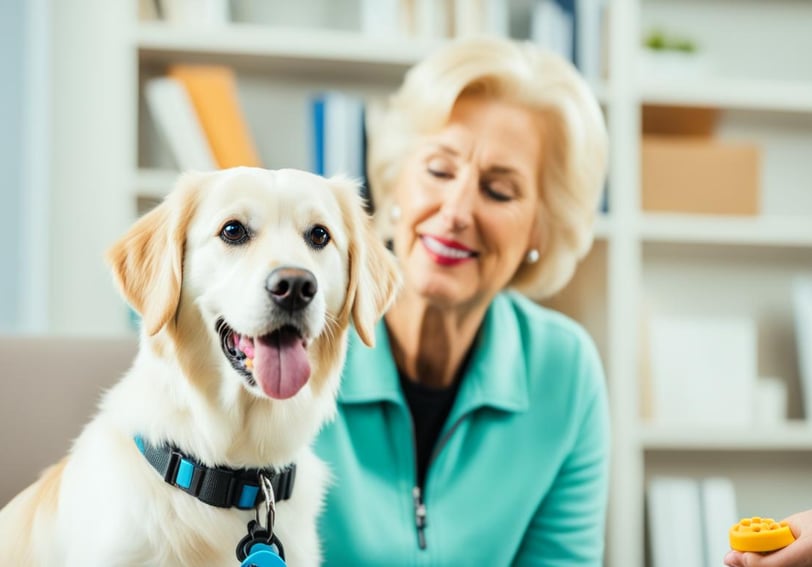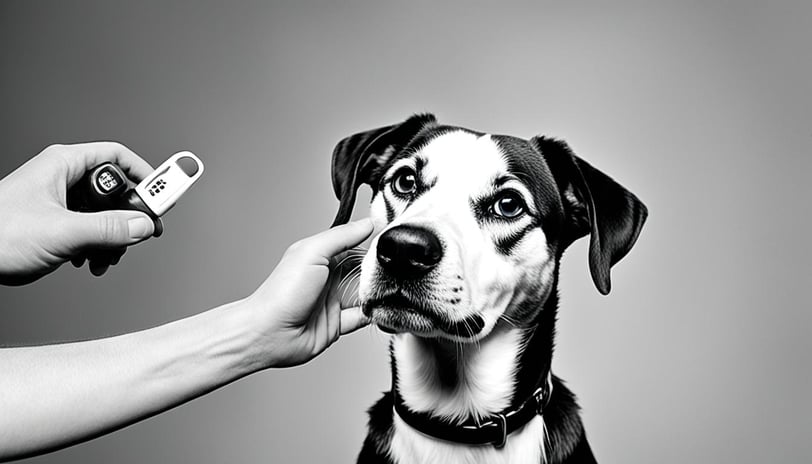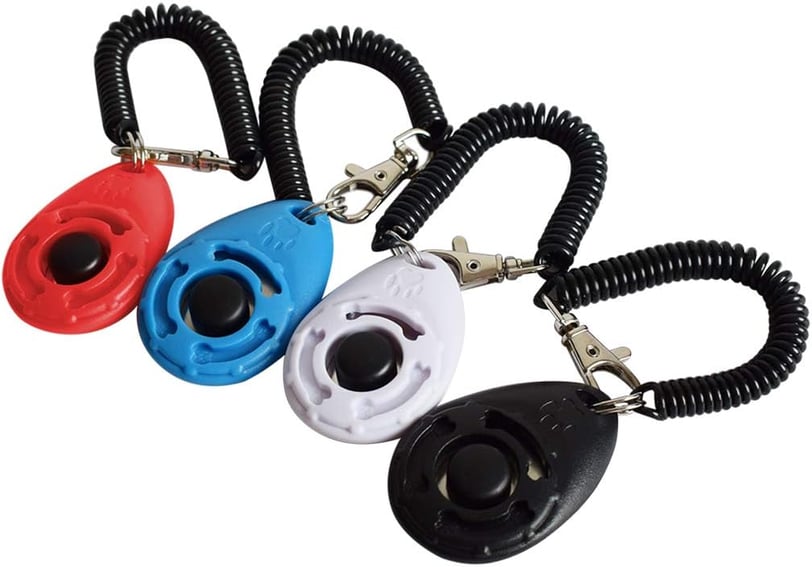Clicker Training for Dogs: A Beginner's Guide
Discover the basics of clicker training for dogs, a positive reinforcement technique that enhances communication, boosts learning, and strengthens the bond with your pet.
The Canine Chronicles
8/27/202410 min read
Key Takeaways
Clicker training is a positive reinforcement technique that uses a distinct clicking sound to mark desired behaviors.
Clicker training can improve communication, training precision, and help you teach complex behaviors through shaping.
The basics of clicker training involve conditioning the dog to associate the click with a reward.
Clicker training can be used to teach a variety of behaviors, from basic commands to advanced tricks.
Proper timing and consistency are key to successful clicker training.
What is a Clicker?
A clicker is a small, handheld device that makes a distinct clicking sound. It's a key tool in dog training, used in positive reinforcement methods. The clicker device lets dog owners mark the exact moment a desired behavior happens.
The idea behind clicker training is straightforward: the click sound links the dog's action with a reward, like a treat or praise. This quick feedback helps the dog know what behavior is being praised, making training better and faster.
The clicker is easy to use and carry. It's small, light, and fits easily in your hand, perfect for training at home or outside. The click sound is clear and consistent, helping your dog link it with the right behavior.
"The clicker is a powerful communication tool that helps bridge the gap between what your dog does and what you want to reward."
Using the clicker in your dog's training helps you precisely mark the behavior you want. This leads to a more effective and rewarding training experience for you and your dog.
The Basics of Clicker Training
Clicker training is a great way to teach dogs new things by rewarding them. It uses a special sound to mark when a dog does something good. This sound is followed by a treat, which makes the dog want to do it again.
Associating the Click with Rewards
The clicker helps you tell your dog exactly when they do something right. When you click and then give them a treat, they learn that the click means a good thing is coming. This makes them want to do the action again to get the reward.
With time and practice, dogs learn which actions get a reward. This method of training dogs using clicker training basics and positive reinforcement clicker training works well.
"The click tells the dog exactly what they did right, and the treat reinforces that behavior."
Learning how to use a clicker can make training your dog easier and more fun. It helps you communicate better and builds trust with your dog.
Benefits of Clicker Training
Clicker training has many benefits for dog owners who want to better their pets' behavior and strengthen their bond. It uses a small device that makes a "click" sound. This method makes communicating with your dog clear and consistent.
Improved Precision and Training Efficiency
Clicker training for dogs is precise. It marks the exact moment a good behavior happens. This lets you reward your dog with a treat or praise right away.
This quick feedback loop speeds up learning. It makes training sessions more efficient and successful.
Shaping Complex Behaviors
Using a clicker to train dogs helps shape complex behaviors. You reward small steps towards the final goal. This way, you can teach complex skills easily.
"Clicker training is an engaging, reward-based approach that many dogs enjoy and respond well to."
The benefits of clicker training for dogs go beyond better training results. It's a positive way to train that keeps your dog interested and happy.
Clicker training is great for teaching basic commands, complex behaviors, or just to bond with your dog. It uses precise communication and positive reinforcement. This helps you and your dog reach your full potential and enjoy training together.
how to clicker train a dog
Clicker training is a great way to teach your dog new tricks and behaviors. It's perfect for first-time dog owners or those wanting to teach their pup more. This guide will walk you through clicker training for beginners.
First, let's talk about the clicker. It's a small device that makes a "click" sound. This sound tells your dog exactly when they've done something right. The trick is to pair the click with a reward, like a treat or praise, to make them want to do it again.
Begin clicker training your dog in a quiet place with no distractions. Click the clicker and then give a treat right away. Do this a few times so your dog learns the click means a reward.
After your dog gets it, use the clicker for specific actions, like sitting or coming when called. Click and treat right when they do what you want.
As your dog gets better, start adding verbal cues with the clicker. This makes learning faster.
Be patient and keep training the same way. Clicker training takes time but is worth it!
With these clicker training for beginners tips, you'll be teaching your dog new tricks in no time. Enjoy the process of how to start clicker training a dog!
"Clicker training is an amazing tool that allows you to communicate with your dog in a clear, positive, and effective way."
Discover the secret to changing your dog's behavior with just a simple click! Clicker training can turn chaos into calm, making training fun and rewarding for you and your dog.
This guide will show you how to clicker train your dog.
It's a powerful way to communicate with your dog, improve training, and teach complex behaviors.
Learn the basics of clicker training, its benefits, and how to start.
This method uses a distinct clicking sound to mark good behaviors. It's a positive way to train your dog.

Training Retrieves and Distance Work
Clicker training is great for learning complex behaviors like retrieving or training from afar. It clicks when the action is done right, linking the action to the reward. This makes training advanced behaviors easier.
For clicker training for dog retrieves, start by clicking for approaching the object. Then, click for touching it, picking it up, and bringing it back. The clicker helps focus on each step of the retrieve.
Using clickers for distance training is also very useful. You can click and reward the dog right when they do the action, even from far away. This makes the dog learn faster and respond better to commands from a distance.
Clicker training lets you teach your dog complex behaviors easily. Break down the behavior into small steps and click when the action is right. This way, you can teach your dog advanced tricks and commands, like complicated retrieves or obedience from far away.
Improving Clarity and Precision
Clicker training makes communication clearer and more precise during training. The click sound marks the exact moment a desired behavior happens. This is great for tricky behaviors or for dogs that get easily excited and need clear feedback.
The clicker is a key tool for clear and accurate training. It signals the exact behavior you want to reward. This makes training clear and effective for everyone involved.
For complex behaviors or those needing precise timing, the clicker is a must-have. It lets trainers reward the exact moment a behavior is done right. This precision is key for teaching complex skills and building a strong training base.
"The clicker's precise feedback is especially helpful for energetic or easily distracted dogs, as it clearly communicates the exact behavior that is being rewarded."
The clicker also boosts training precision. It gives immediate, clear feedback. This helps dogs learn faster and more accurately, making training more successful.


The clicker's impact on improving training clarity and precision is huge. It helps bridge the gap between trainer and dog, leading to better, more successful training outcomes.
Shaping Behaviors
Clicker training is a great way to shape behaviors. It rewards small steps towards the final behavior. This method lets dogs take an active part in learning and makes teaching complex skills fun.
It's different from luring or using physical cues. Dogs learn to figure out what gets them a reward. This method, known as what is behavior shaping in clicker training, uses the dog's natural desire to learn and experiment.
As the dog gets closer to the desired behavior, the trainer clicks and treats. This guides them towards the end goal.
Clicker training to teach complex behaviors is very flexible. It can be used for simple tricks or complex tasks. Breaking down the behavior into smaller steps helps dogs learn and gain confidence.
Using clickers for incremental training is a clear way to talk to your dog. The click marks the exact right behavior, making training precise. This is great for complex behaviors that need many steps.
"Clicker training is like having a remote control for your dog's behavior. The click marks the exact moment they do something right, and the treat reinforces that behavior."
Using what is behavior shaping in clicker training opens up many possibilities. It lets dogs help in their learning, creating a positive bond. This approach makes teaching complex behaviors possible.
Introducing Vocal Commands
As you move forward in your dog training with clicker training, it's time to add vocal commands. You can link the clicked behaviors with certain words. This makes it easier to switch from using the clicker to just verbal praise.
By pairing clickers and commands, your dog learns the link between a word and a behavior. This step is key in transitioning from clickers to verbal praise. It keeps the positive reinforcement method you've been using.
Start by saying the command right before clicking and giving a treat. This helps your dog connect the word with the action.
Slowly wait longer between the command and the click until your dog answers the word alone.
After your dog gets the hang of it, stop using the clicker. Just use the verbal cue and treats or praise.
"Introducing vocal commands alongside the clicker click is a game-changer in dog training. It allows for a smooth transition from one tool to the other, while maintaining the positive association with the desired behavior."
Success comes from using verbal cues with clicker training and being patient. With time and consistency, your dog will learn the verbal commands well. Then, you can fully transition from clickers to verbal praise for smooth training.


Phasing Out the Clicker
When your dog knows the behaviors you've taught with the clicker well, it's time to use other rewards instead. The clicker helps mark good behaviors and gives treats for them. But once a behavior is well learned, you can start to fade the clicker and use other rewards.
When to Stop Using the Clicker
Stop using the clicker when your dog really gets the behavior you're teaching. This usually takes a few tries, and the dog does the behavior when you ask. At this point, the clicker has helped shape the behavior, and it's time to transition from clicker to other rewards.
Start using words of praise or petting as rewards, slowly stopping the clicker-treat cycle.
Use the clicker less often, giving a treat now and then, to keep the dog excited about the behavior.
Stop using the clicker altogether, using the new rewards to keep the behavior strong.
This slow process of phasing out the clicker shows your dog that the behavior is still important and rewarding, even without the click sound.
"The clicker is a training tool, not a crutch. Once a behavior is learned, it's important to transition away from the clicker to maintain the dog's motivation and engagement."
Knowing when to stop using a clicker in training and how to switch to other rewards helps your dog keep doing well and stay excited about learning new things.
Tips for Successful Clicker Training
Clicker training is a great way to teach your dog new things. But, it needs precision and consistency. Here are some tips to help you and your dog succeed with this method:
Timing is Everything
The secret to clicker training is precise timing. You must click right when your dog does what you want, linking the sound with the reward. A delay can confuse your dog and slow down learning.
Consistency is Key
Being consistent is key when using a clicker effectively. Always give a treat after clicking, and use the same clicker and rewards in all sessions. Changing your approach can make it harder for your dog to learn.
Keep Treats Small
Use small, bite-sized treats in clicker training. Big treats can make your dog overeat and lessen the clicker's effectiveness. Choose high-value, low-calorie treats to keep your dog eager without overfeeding.
Follow these tips for best practices in clicker training dogs. You'll build a strong, positive bond with your dog. You'll also teach them new skills clearly and precisely.
"Clicker training is a powerful tool that allows you to communicate with your dog in a clear and effective way."
Conclusion
Clicker training is a powerful way to teach your dog. It uses positive reinforcement to make training fun and effective. By rewarding your dog with treats for good behavior, you create a strong connection.
This method is great for teaching simple commands or complex tricks. It makes training clear and precise. Your dog learns what actions are rewarded, making training fun for both of you.
If you want to improve your dog's training, try clicker training. It's a versatile tool that strengthens your bond with your dog. With clicker training, you can help your dog reach their full potential and build a strong partnership.
FAQ
What is a clicker?
A clicker is a small plastic device that makes a distinct sound when pressed. It's used in dog training to help teach new behaviors.
How does clicker training work?
Clicker training uses positive reinforcement. When your dog does something good, you click a clicker. Then, you give them a treat right away.
What are the benefits of clicker training?
Clicker training has many benefits. It improves how well you communicate and train your dog. It also makes learning fun and rewarding for your dog.
How do I start clicker training my dog?
Start by introducing the clicker and linking it with treats. Then, use it to teach simple commands and tricks. Next, add verbal cues and slowly stop using the clicker as your dog learns.
When is the clicker especially useful in training?
The clicker is great for training hard behaviors. It marks the exact moment of the behavior, making training clear and effective.
How does clicker training improve communication and precision?
The click marks the exact behavior you want to reward. This is very helpful for tricky behaviors or for dogs that get easily excited.
How does clicker training work for shaping behaviors?
Clicker training is perfect for shaping behaviors. You reward small steps towards the final behavior. This makes training fun and lets your dog learn complex skills.
How do I transition from the clicker to verbal cues?
As your dog gets better, start using verbal commands with the behaviors you've clicked. This helps you stop using the clicker and use verbal praise instead.
When should I stop using the clicker?
Stop using the clicker when a behavior is well learned. Then, use other rewards like praise or toys instead.
What are some tips for successful clicker training?
Important tips include clicking at the right time and being consistent. Use small treats to avoid overfeeding. These tips will help you and your dog have positive training sessions.
Source Links
Clicker Training for Dogs, Step by Step - https://yourpetandyou.elanco.com/us/behavior/guide-clicker-training-your-dog
No title found - https://www.akc.org/expert-advice/training/clicker-training-your-dog-mark-and-reward/
Clicker Training 101: A Quick Beginner’s Guide - https://www.drjensdogblog.com/clicker-training-101-a-quick-beginners-guide/
Further reading
Ultimate guide to dog training
Teach your dog the lay down command
Choosing the best dog whistle
Thanks and best regards
The Canine Chronicles
Click here for a healthy canine!
This post may contain affiliate links. If you make a purchase through one of these links, we may earn a small commission at no additional cost to you. We only recommend products and services that we have personally used and believe will add value to our readers. Your support helps us continue to provide valuable content. Thank you for your support!


